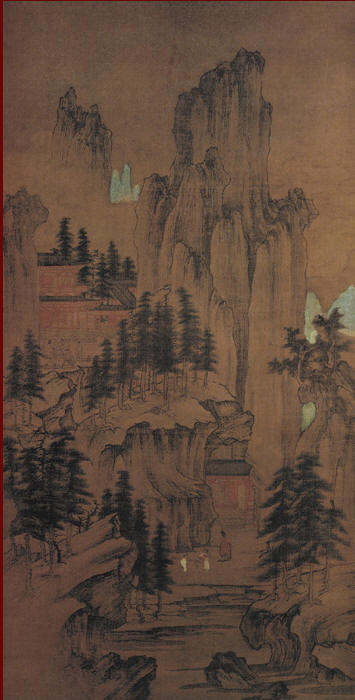907: The Artistic Emergence of the Five Dynasties
The Five Dynasties period (907-960) marks a crucial transition in the history of Chinese art. While the northern part of the country suffered invasions by non-Han peoples and saw its economy ravaged by conflicts, artists developed an innovative pictorial expression. This turbulent era paradoxically became a crucible of creativity where painters, particularly those who took refuge in the south, transformed their distress into works of unprecedented depth. Two distinct schools emerged: the Northern School (北方画派) characterized by monumental landscapes with stark forms, and the Southern School (南方画派) with more harmonious compositions and exuberant vegetation.


Painting on silk (106.5 × 54 cm)
The Rise of Regional Schools
Political disintegration favored the development of regional artistic centers. In Nanjing, the painter 徐熙 revolutionized flower-and-bird painting (花鸟画) with his "freehand" style (落墨), using ink expressively on raw silk. Contemporaneously, 黄筌 in Chengdu perfected the "detail-focused" style (工笔), influencing court painting for centuries. This stylistic dichotomy illustrates how territorial fragmentation stimulated creative diversity.
Revolution in Landscape Painting
Jing Hao (荆浩), active in the mountains of Shanxi, theorized in his Bifaji (笔法记) the "six principles of landscape," including the famous "dragon-bone" (骨法) structuring rocky masses. His disciple Guan Tong (关仝) radicalized this approach with vertical compositions of steep cliffs. In the south, Dong Yuan (董源) and Juran (巨然) developed misty horizontal landscapes using "ink dots" (点苔) to suggest lush vegetation.
Major Technical Innovations
- Ink splashing (泼墨) for atmospheric effects
- Development of graded wash (渲染)
- Expressive use of dry brush (渴笔)
- Improvement of the vertical scroll format (立轴)
Narrative and Court Painting
Gu Hongzhong (顾闳中) revolutionized narrative painting with his Night Revels of Han Xizai (韩熙载夜宴图), depicting over five meters the decadence of a minister through an innovative spatio-temporal continuum. Zhou Wenju (周文矩), an official painter of the Southern Tang, excelled in court portraits using the "trembling wire-line" (战笔) to render the texture of fabrics. These works document as much as they criticize aristocratic manners.
The Imperial Legacy
Li Yu (李煜), the last emperor of the Southern Tang and an accomplished poet, founded the Hanlin Academy (翰林图画院) which would become a model for the Song Academy. His patronage fostered the synthesis between poetry and painting, inaugurating the tradition of 诗书画 (the trinity of poetry-calligraphy-painting). Zhao Gan (赵干), a protégé of Li Yu, produced the famous Spring Waters Scroll, anticipating the topographical realism of the Song.
Main Masters of the Five Dynasties
| Artist | Specialty | Contribution |
|---|---|---|
| 李成 | Landscape | Inventor of the "hemp-fiber crackle" for rocks |
| 郭忠恕 | Architecture | Mathematical precision in palace representations |
| 石恪 | Figures | Expressionist style precursor to Chan painters |
| 黄居寀 | Flowers-birds | Perfection of ornithological realism |
Transmission and Influence
The art of the Five Dynasties constitutes an essential bridge between Tang classicism and the Song golden age. Technical innovations such as Dong Yuan's atmospheric perspective (空气透视) influenced the great masters of the 11th century like Fan Kuan. Xu Xi's expressive use of ink heralded the emergence of literati painting (文人画). This period demonstrates how political chaos can paradoxically give rise to major aesthetic advances, with artists transforming instability into a creative laboratory.
